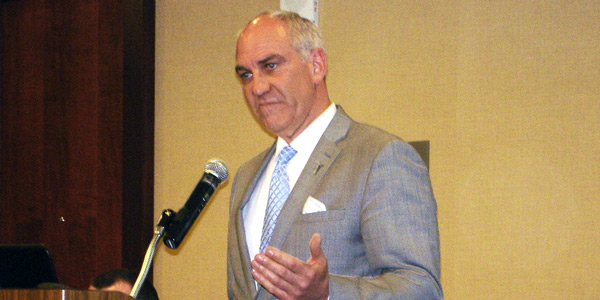By Jason Fordney
ANNAPOLIS, Md. — A senior federal official told offshore wind energy developers last week that the Trump administration supports their cause as the industry looks to build momentum after putting the first U.S. project into service last year.
“I can attest to the fact that offshore wind is very much a part of the portfolio of energy that [new Department of Interior leaders] have come on board to promote,” Bureau of Ocean Energy Management Acting Director Walter Cruickshank told dozens of attendees April 20 at the 2017 International Offshore Wind Partnering Forum. “So, we can put that question behind us and talk about the future.”
The Obama administration ended its last term with two landmarks in the development of the nascent resource. In December, Deepwater Wind’s 30-MW Block Island Wind Farm off Rhode Island became the first offshore facility to deliver electricity to the U.S. grid, days before developer Statoil Wind US agreed to pay BOEM a record $42.5 million to lease a parcel off New York.
During his campaign, President Trump promised to revitalize the fossil fuel industry and to renege on the carbon emissions cuts promised in the Paris Agreement on climate change, creating concern that his appointees might curtail federal support of renewable energy.
But Cruickshank, a long-time Interior Department official who was deputy director of BOEM at its inception in 2011, noted that the agency completed its seventh competitive lease sale for offshore wind in March. Avangrid Renewables presented the high bid of about $9 million to develop a 122,000-acre wind energy area off Kitty Hawk, N.C., a deal that Interior Secretary Ryan Zinke called a “big win.”
Cruickshank said the agency hopes to identify sites for development off the California shore by June. The seabeds near Massachusetts, New York/New Jersey, the Delmarva Peninsula, the Carolinas, Oregon and Hawaii are also being eyed for development, he said.
At the three-day Annapolis forum, sponsored by the Business Network for Offshore Wind, offshore developers described the unique technical and regulatory requirements for bringing their projects to fruition. Design challenges are highly complex, and the scale of equipment and logistics is huge, while much of the required knowledge and experience is in its infancy in the U.S., relative to Europe.
“This industry does not exist in the U.S. — it is nascent,” said Paul Rich, director of policy development for offshore developer US Wind. The company is vying with Deepwater Wind to be the first to build off the coast of Maryland.
Rich told the forum that it is critical that they collaborate, and told them to be “bold” and to “go big, go large.”
US Wind’s proposed wind farm on an 80,000-acre site 17 miles off Ocean City, Md., would have 187 turbines producing 750 MW. The company won its BOEM lease in August 2014 for $8.7 million and has already invested more than $20 million in its project. The wind farm, which still needs federal permits to move ahead, has a total price tag of $2.5 billion.
The Maryland Public Service Commission is due to decide by May 17 whether US Wind or Deepwater subsidiary Skipjack Offshore Energy will receive offshore renewable energy credits to help fund their proposed projects. The credits, a subsidy that will later be transferred to electricity suppliers to meet renewable energy requirements, spring from 2013 legislation that created a carve-out for offshore wind in Maryland’s renewable portfolio standard. The legislation directs that projects must be 10 to 30 miles off the coast, able to connect to the PJM grid and approved by the state commission.
Skipjack has a much more modest plan for a 120-MW wind farm. The company argues for a more measured approach to development and says its site — 26 miles from the Ocean City Pier and 19.5 miles from its closest point in Maryland — would have much less visual impact.
About 72% of Maryland voters support offshore wind, according to a poll by Annapolis-based marketing analysis firm Opinionworks conducted in 2013. But siting the projects is difficult because of the massive infrastructure and environmental footprints involved. The costs of building offshore are almost three times that of onshore wind according to the U.S. Energy Information Administration’s levelized cost of energy calculations, although offshore turbines are larger and have substantially higher capacity factors.
In addition, even a small visual presence of turbines peeking above the horizon can create complaints in coastal areas. Ocean City officials raised concerns about the visual impact of the proposed US Wind turbines and their possible effect on tourism. The company this month offered to move the project from 12 to 17 miles offshore, adding millions of dollars in costs.
Developers must also deal with the lengthy and costly generator interconnection process faced by land-based generation.
But after setbacks to projects planned off of Atlantic City, N.J., and Martha’s Vineyard, Mass., the industry has reason for optimism. Last August, the Massachusetts legislature approved legislation ordering procurement of 1,600 MW of offshore wind by 2027. (See Cuomo Proposes 2,400 MW of Offshore Wind by 2030.)
Liz Burdock, executive director of the Business Network for Offshore Wind, says there is a “4.25-GW pipeline” of offshore wind projects in the U.S., large enough to spark a supply chain similar to that in Europe, which has been building utility-scale offshore wind for more than 15 years. The continent boasts 12.6 GW from nearly 4,000 turbines in 10 countries, according to industry group WindEurope.
U.S. developers are looking to utilize the expertise of European offshore wind developers — as well as companies that service U.S. offshore oil and gas drilling — to build capabilities here.
Last week’s forum attracted more than 200 companies and labor unions that would like to be part of that supply chain, in addition to university and government researchers and others.


